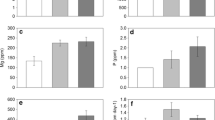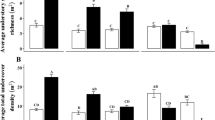Abstract
Numerous mechanisms are proposed to explain why exotic plants successfully invade natural communities. However, the positive effects of native engineers on exotic plant species have received less consideration. We tested whether the nutrient-rich soil patches created by a native ecological engineer (refuse dumps from the leaf-cutting ant Acromyrmex lobicornis) increase the performance of exotic more than native plants. In a greenhouse experiment, individuals from several native and exotic species were planted in pots with refuse dumps (RDs) and non-nest soils (NNSs). Total plant biomass and foliar nutrient content were measured at the end of the experiment. We also estimated the cover of exotic and native plant species in external RDs from 54 field ant nests and adjacent areas. Greenhouse plants showed more biomass and foliar nutrient content in RDs than in NNS pots. Nevertheless, differences in the final mean biomass among RD and NNS plants were especially great in exotics. Accordingly, the cover of exotic plants was higher in field RDs than in adjacent, non-nest soils. Our results demonstrated that plants can benefit from the enhanced nutrient content of ant RDs, and that A. lobicornis acts as an ecosystem engineer, creating a substrate that especially increases the performance of exotics. This supports the fluctuating resource hypothesis as a mechanism to promote biological invasions, and illustrates how this hypothesis may operate in nature. Since ant nests and exotic plants are more common in disturbed than in pristine environments, the role of ant nests in promoting biological invasions might be of particular interest. Proposals including the use of engineer species to restore disturbed habitats should be planned with caution because of their potential role in promoting invasions.


Similar content being viewed by others
References
Badano E, Villaroel E, Bustamante R, Marquet P, Caviares L (2007) Ecosystem engineering facilitates invasions by exotic plants in high-Andean ecosystems. J Ecol 95:682–688
Brooks M (2003) Effects of increased soil nitrogen on the dominance of alien plants in the Mojave Desert. J Appl Ecol 40:344–353
Burke M, Grime JP (1996) An experimental study of plant community invasibility. Ecology 77:776–790
Byers J, Cuddington K, Jones C, Talley T, Hastings A, Lambrinos J, Crooks J, Wilson W (2006) Using ecosystem engineers to restore ecological systems. Trends Ecol Evol 21:493–500
Catford J, Jansson R, Nilsson C (2009) Reducing redundancy in invasion ecology by integrating hypotheses into a single theoretical framework. Divers Distrib 15:22–40
Clavero M, García-Berthou E (2005) Invasive species are a leading cause of animal extinctions. Trends Ecol Evol 20:110
Correa M (1969–1998) Flora Patagónica, vol 7. INTA, Buenos Aires
Correa M, Silva P, Wirht R, Tabarelli M, Leal I (2010) How leaf-cutting ants impact forests: drastic nest effects on light environment and plant assemblages. Oecologia 162:103–115
Coutinho L (1982) Aspectos ecologicos de sauva no cerrado. Os murundus de terra, as características psamofíticas das especies de sua vegetaçao e sua invasao pelo Capim Gordura. Rev Bras Biol 42:147–153
Crooks J (2002) Characterizing ecosystem-level consequences of biological invasions: the role of ecosystem engineers. Oikos 97:153–166
Currie C, Scott J, Summerbell R, Malloch D (1999) Fungus-growing ants use antibiotic-producing bacteria to control garden parasites. Nature 398:701–704
D’Antonio C, Hughes R, Mack M, Hitchcock D, Vitousek P (1998) The response of native grasses to the removal of invasive exotic grasses in the seasonally dry Hawaiian woodland. J Veg Sci 9:699–712
Daehler C (2003) Performance comparisons of co-occurring native and alien invasive plants: implications for conservation to agricultural weeds. Biol Conserv 84:167–180
Davis M, Pelsor M (2001) Experimental support for a resource-based mechanistic model of invasibility. Ecol Lett 4:421–428
Davis M, Grime J, Thompson K (2000) Fluctuating resource in plant communities: a general theory of invasibility. J Ecol 88:528–534
Farji-Brener AG (2001) Why are leaf-cutting ants more common in early secondary forests than in old-growth tropical forests? An evaluation of the palatable forage hypothesis. Oikos 92:169–177
Farji-Brener AG, Ghermandi L (2000) The influence of nests of leaf-cutting ants on plant species diversity in road verges of northern Patagonia. J Veg Sci 11:453–460
Farji-Brener AG, Ghermandi L (2004) Seedling recruitment in the semi-arid Patagonian steppe: facilitative effects of refuse dumps of leaf-cutting ants. J Veg Sci 15:823–830
Farji-Brener AG, Ghermandi L (2008) Leaf-cutting ant nests near roads increase fitness of exotic plant species in natural protected areas. Proc R Soc B 275:1431–1440
Farji-Brener AG, Illes A (2000) Do leaf-cutting ant nests make “bottom up” gaps in neotropical rain forests? A critical review of the evidence. Ecol Lett 3:219–227
Farji-Brener AG, Margutti L (1997) Patterns of plant species in relation to Acromyrmex lobicornis nest-mounds on roadside vegetation in northwest Patagonia. Int J Ecol Environ Sci 23:37–47
Farji-Brener AG, Sasal Y (2003) Is dump material an effective small-scale deterrent to herbivory by leaf-cutting ants? Ecoscience 10:151–154
Farji-Brener AG, Silva J (1995) Leaf-cutting ant nests and soil fertility in a well-drained savanna in western Venezuela. Biotropica 27:250–253
Gibson J, Connolly J, Hartnett D, Weidenhamer J (1999) Designs for greenhouse studies of interactions between plants. J Ecol 87:1–16
Hastings A, Byers J, Crooks J, Cuddington K, Jones C, Lambrinos J, Talley T, Wilson W (2007) Ecosystem engineers in space and time. Ecol Lett 10:153–164
Horvitz C, Schemske D (2002) Effects of plant size, leaf herbivory, local competition and fruit production on survival, growth and future reproduction of a neotropical herb. J Ecol 90:279–290
Jones C, Lawton J, Shachar M (1994) Organisms as ecosystem engineers. Oikos 69:373–386
Jones C, Lawton J, Shachar M (1997) Positive and negative effects of organisms as physical ecosystem engineers. Ecology 78:839–841
Larcher W (1995) Physiological plant ecology, 3rd edn. Springer, New York
Levine JM (2000) Species diversity and biological invasions: relating local process to community pattern. Science 288:852–854
Meiners SJ (2007) Native and exotic plant species exhibit similar population dynamics during succession. Ecology 88:1098–1104
Moutinho P, Nepstad D, Davidson E (2003) Influence of leaf-cutting ant nests on secondary forest growth and soil properties in Amazonia. Ecology 84:1265–1276
Parker I, Simberloff D, Lonsdale W, Goodell K, Wonham M, Kareiva P, Williamson M, Von Holle B, Moyle P, Byers J, Goldwasser L (1999) Impact: toward a framework for understanding the ecological effects of invaders. Biol Inversions 1:3–19
Richards JE (1993) Chemical characterization of plant tissue. In: Carter MR (ed) Soil sampling and methods of analysis. Canadian Society of Soil Science, Pinawa, pp 115–139
Shea K, Chesson P (2002) Community ecology theory as a framework for biological invasions. Trend Ecol Evol 17:170–176
Siemann E, Rogers W (2007) The role of soil resources in an exotic tree invasion in Texas coastal prairie. J Ecol 95:689–697
Sternberg L, Pinzon M, Moreira M, Moutinho P, Rojas E, Herre A (2007) Plants use macronutrients accumulated in leaf-cutting ant nests. Proc R Soc B 274:315–321
Suding K, LeJeune K, Seastdet T (2004) Competitive impacts and responses of an invasive weed: dependencies on nitrogen and phosphorus availability. Oecologia 14:526–535
Vasconcelos H, Vieira-Neto E, Mundim F, Bruna E (2006) Roads alter the colonization dynamics of a keystone herbivore in Neotropical savannas. Biotropica 38:661–665
Von Holle B, Simberloff D (2005) Ecological resistance to biological invasion overwhelmed by propagule pressure. Ecology 86:3212–3218
Wirth R, Herz H, Rye I, Beyschlag W, Hölldobler B (2003) Herbivory of leaf-cutting ants. Springer, Berlin
Wirth R, Meyer S, Almeida W, Araujo M, Barbosa V, Leal I (2007) Increasing densities of leaf-cutting ants (Atta spp.) with proximity to the edge in a Brazilian Atlantic forest. J Trop Ecol 23:501–505
Wright J, Jones C (2004) Predicting the effects of ecosystem engineers on patch-scale species richness from primary productivity. Ecology 85:2071–2081
Zou J, Rogers W, Siemann E (2007) Differences in morphological and physiological traits between native and invasive populations of Sapium sebiferum. Funct Ecol 21:721–730
Acknowledgments
This research was partially funded by CONICET (PIP 5110) and ANPCyT (PICT 25314), Argentina. We thank Irene Khavin, Cameron Naficy, and three anonymous reviewers for their useful comments.
Author information
Authors and Affiliations
Corresponding author
Additional information
Communicated by Bryan Foster.
Electronic supplementary material
Below is the link to the electronic supplementary material.
Rights and permissions
About this article
Cite this article
Farji-Brener, A.G., Lescano, N. & Ghermandi, L. Ecological engineering by a native leaf-cutting ant increases the performance of exotic plant species. Oecologia 163, 163–169 (2010). https://doi.org/10.1007/s00442-010-1589-1
Received:
Accepted:
Published:
Issue Date:
DOI: https://doi.org/10.1007/s00442-010-1589-1




